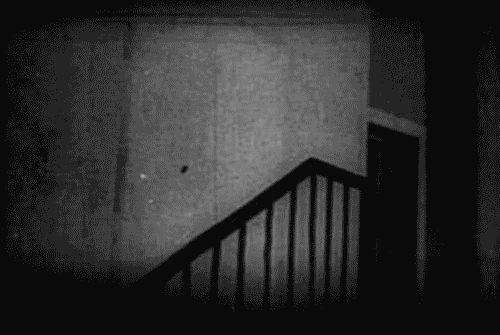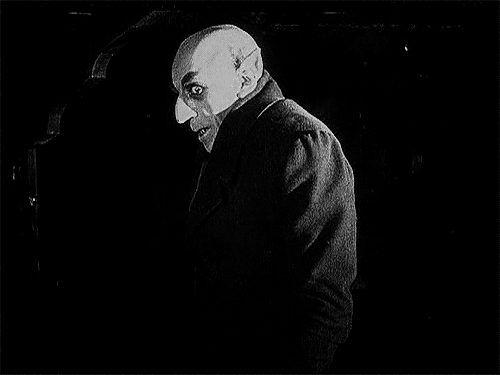Nosferatu was one of the first horror movies ever filmed: it has set the bar and established precedent for over 90 years of sweaty palms and racing pulses. Over this time our threshold for being scared has evolved and the horror film industry has changed in tune with this standard of fear. Now scary movies generally follow a basic formula: an attractive person with a normal life does something and people around him/her begin to die. I am someone who greatly appreciates a good scary movie, but I find myself consistently disappointed whenever I go to theaters and see the same old plot repeated over and over again.
I’ve read the book version of Dracula and expected more from the movie. I didn’t dislike it, but I did not like it either. I was a little bit bored. But that was mainly due to the fact that it didn’t surprise me. However, as a classic scary movie I can imagine it was very surprising for the people who went to view it in 1922.
When I was discussing Nosferatu with other students, some people mentioned that it was ‘cliché.’ My response was: how can it be cliché if it was one of the first films of its genre? If anything, it set the standards for what a cliché scary movie would be and films today follow in its footsteps. We have all seen too many scary movies with similar plots and therefore could not objectively view Nosferatu. In the 1920’s this film was probably revolutionary and one of a kind. All of the special effects and lighting that we modern viewers consider ‘cheesy’ were technological marvels in the early 20th century.
What watching this film and subsequently hearing the opinions of my classmates reminded me of is my love for Alfred Hitchcock films. I own about half of the movies he ever directed and all of my favorite thrillers are his. But whenever I show “Psycho” or “North by Northwest” to someone my age that grew up with “The Grudge” and “Strangers” they are often unimpressed.
 http://www.ghosthuntingtheories.com/2012/10/classic-horror-birds.html
http://www.ghosthuntingtheories.com/2012/10/classic-horror-birds.html
Not to sound like a movie snob, but these days it doesn’t seem like we appreciate the psychology of and skilled actors in scary movies. We want the shock factor of someone popping out from behind a curtain in “When A Stranger Calls” and the gore of “Texas Chainsaw Massacre.”
But when I watch a scary movie I don’t want to know the ending. I remember watching the movie “Prom Night” and being able to predict the entire plot line five minutes in. For me the ‘scary’ part of a scary movie is derived from true suspense in the script, not from the disposable friends of the main character being stabbed in closets.

 http://robsmovievault.wordpress.com/page/55/
http://robsmovievault.wordpress.com/page/55/
This is what I always loved about Alfred Hitchcock films. They play with more of our emotions than just fear: they go deeper than someone being chased through a basement by a masked man with a knife. I refer to these films as ‘psychological thrillers’ because each one is committed to manipulating our minds down one path and then taking a drastic twist in another direction. When his most infamous movie “Psycho” was released, Hitchcock bought all available copies of the book the film was based on so that no one would know the ending beforehand. He also closed the set during filming and had cast and crew-members sign a confidentiality agreement stating that they would not reveal the ending. This is taking surprise seriously.
 http://www.theguardian.com/film/2010/mar/29/psycho-body-double-marli-renfro
http://www.theguardian.com/film/2010/mar/29/psycho-body-double-marli-renfro
After watching dozens of movies with the same basic plot-line, Nosferatu did not seem very inventive. But for its time it was new and unexpected. I did not love the film, largely because I was able to guess the ending easily, but I can take a step back and appreciate that in 1922 I would have probably been on the edge of my seat.










.gif)












 movie -when Hutter hid from Nosferatu on his second night in Carpathian. This was heighten by Murnau’s effective use of shadows. The way he employed that technique reminded me of the many movies I’ve watched that have relied on mysterious, dark corners and shadowy figures. To engross the viewer, Murnau also engages the use of the familiar and unfamiliar. Nosferatu is a compelling figure in the film because his manner of actions and general appearance is disturbingly strange. His bulbous head, disproportionate body, clawed hands, the list goes on and on. Each unfamiliarity pushes us further away from connecting to Nosferatu’s true identity. When viewers only consider the one-sided, biased perspective of the narrator, there is an entirely unexplored narrative in the perspective of Nosferatu. How did he become a vampire? Are his cravings for blood more than just a survival tactic?
movie -when Hutter hid from Nosferatu on his second night in Carpathian. This was heighten by Murnau’s effective use of shadows. The way he employed that technique reminded me of the many movies I’ve watched that have relied on mysterious, dark corners and shadowy figures. To engross the viewer, Murnau also engages the use of the familiar and unfamiliar. Nosferatu is a compelling figure in the film because his manner of actions and general appearance is disturbingly strange. His bulbous head, disproportionate body, clawed hands, the list goes on and on. Each unfamiliarity pushes us further away from connecting to Nosferatu’s true identity. When viewers only consider the one-sided, biased perspective of the narrator, there is an entirely unexplored narrative in the perspective of Nosferatu. How did he become a vampire? Are his cravings for blood more than just a survival tactic?